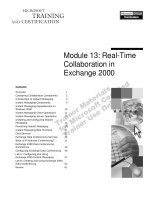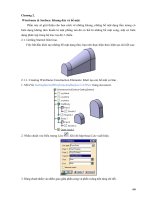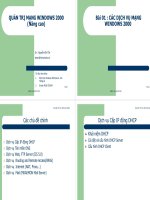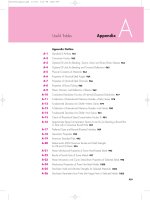Tài liệu Mechanical Engineering ME 481 Vehicle Design Fall 2000 pptx
Bạn đang xem bản rút gọn của tài liệu. Xem và tải ngay bản đầy đủ của tài liệu tại đây (337.11 KB, 39 trang )
Mechanical Engineering
ME 481
Vehicle Design
Fall 2000
Lecture Notes
By
Richard B. Hathaway, Ph.D., PE
Professor
Mechanical and Aeronautical Engineering
Section 1
Energy Consumption
and
Power Requirements in Design
2
Aerodynamics and Rolling Resistance
GENERAL FORMULAS - AERODYNAMIC
Dynamic Pressure:
2
2
1
vP
d
Drag Force:
)(
2
1
2
REfAvF
d
ACvF
dd
2
2
1
2
0
)()2.1(
2
1
vvACF
dd
Aero Power
f(RE) A
V
(2)
= P
3
C
d
= coefficient of drag = air density 1.2 kg/m
3
A = projected frontal area (m
2
) f(RE) = Reynolds number
v = vehicle velocity (m/sec) V
0
= headwind velocity
ENGLISH UNITS
V
A
C
)
10
X (6.93 =
HP
3
d
-6
aero
where: A = area (ft
2
) V = velocity (MPH) C
d
= drag coefficient
3
SI UNITS
W
kW
AC
V
(2)
= P
d
3
KW
1000
1
1000
3600
2.1
3
)(
862
0
2
VV
V A
C
x )
10
x .(1 =
P
d
-6
aero
P = power (kw) A = area (m
2
)
V = velocity (KpH) V
0
= headwind velocity
C
d
= drag coefficient = 1.2 kg/m
3
GENERAL FORMULAS – ROLLING RESISTANCE
ENGLISH UNITS
375
V
x W
C
=
HP
rrrr
where: C
rr
= coefficient of rolling resistance W = weight (lbs) V = velocity (MPH)
SI UNITS
V x M x
C
x )
10
x (2.72 =
P
V x M x
C
x
3600
9.81
=
P
rr
3-
rr
rrrr
where: P = power (kw) C
rr
= coefficient of rolling resistance
M = mass (kg) V = velocity (KpH)
4
TRACTIVE FORCE REQUIREMENTS.
Vehicles require thrust forces, generated at the tires, to initiate and maintain motion. These forces
are usually referred to as tractive forces or the tractive force requirement. If the required tractive
force (F) is broken into components the major components of the resisting forces to motion are
comprised of acceleration forces (F
accel
= ma & I forces), Gradeability requirements (F
grade
),
Aerodynamic loads (F
aero
) and chassis losses (F
roll resist
).
F = F
aero
+ F
roll resist
+ F
grade
+ F
accel
= (/2) C
d
A v
2
+ C
rr
m g + %slope m*g + m a
= (/2) C
d
A v
2
+ m g{C
rr
+ % slope + a/g}
in SI units:
A = frontal area (m
2
) v = velocity (m/s) m = mass (kg)
C
rr
= coefficient of roll resistance (N/N) usually approx .015
C
d
= coefficient of aero drag for most cars .3 - .6
% slope = Rise/Run = Tan of the roadway inclination angle
Steady state force are equal to the summation of F
aero
+ F
roll resist
+ F
grade
Fgrade resist Froll Faero
ss
F
Transient forces are primarily comprised of acceleration related forces where a change in velocity
is required. These include the rotational inertia requirements (F
I
) and the translational mass
(F
ma
) requirements, including steady state acceleration.
VEHICLE ENERGY REQUIREMENTS.
The energy consumption of a vehicle is based on the tractive forces required, the mechanical
efficiency of the drive train system, the efficiency of the energy conversion device and the
efficiency of the storage system. Examples of the above might best be demonstrated with the
following.
Storage efficiency:
A flywheel used for energy storage will eventually lose its total energy stored due to
bearing and aerodynamic losses. A storage battery may eventually discharge due to
intrinsic losses in the storage device. These losses can be a function of the % of the total
system capacity at which the system is currently operating. A liquid fuel usually has
extremely high storage efficiency while a flywheel may have considerably les storage
efficiency. Both however have the storage efficiency a function of time.
5
100x
E
EE
EfficiencyStorge
initial
fianlinitial
store
Conversion efficiency:
An internal combustion engine changes chemical energy to mechanical energy. The
system also produces unwanted heat and due to moving parts has internal friction which
further reduces the system efficiency. A storage battery has an efficiency loss during the
discharge cycle and an efficiency loss during the charge cycle. These efficiencies may be
a function of the rate at which the power is extracted.
100x
E
PE
EfficiencyConversion
fuel
deliveredfuel
conv
mechanicalthermalconv
x
Drive system Efficiency:
Conversion of chemical or electrical to mechanical energy does not complete the power
flow to the wheels. Drive train inefficiencies further reduce the power available to
produce the tractive forces. These losses are typically a function of the system design and
the torque being delivered through the system.
100x
P
PP
EfficiencyMechanical
sourcepower
tractivesourcepower
drivemech
n
redredreddrivemech
xx ......
21
6
Reasonable Efficiencies to use for cycle comparisons
(Efficiencies shown are only approximations)
Electric Motor (Peak) = 95%
Electric Motor Efficiency (Avg if 1 spd Trans) = 75%
Electric Motor Efficiency (Avg if CVT) = 95%
Transmission Efficiency
(0.95)
=
1)-(R
Battery Efficiency (Regen) = 75-85%
Battery & Generator Efficiency (Regen) = 50-55%
Battery & Motor Efficiency (Accel) = 80%
Solar Cell Efficiency = 15%
IC Engine (Peak Efficiency) = 30%
Flywheel Efficiency
(Storage and Conversion Average) = 70%
7
Experimental Coast Down Testing
1) Perform a high speed and a low speed test with an incremental ( 5km/hr) velocity change at
each velocity.
2)High Speed Low Speed
V
a1
= 60 km/h V
a2
=
20 km/h
V
b1
= 55 km/h V
b2
= 15 km/h
3) Record the times over which the velocity increments occur.
T
h
= 4 sec T
l
= 6 sec
4) Determine the mean speed at each velocity.
5) Determine the mean deceleration at each velocity.
6) Determine the drag coefficient
7) Determine the coefficient of rolling resistance.
8
h
kmvv
v
ba
2
11
1
h
kmvv
v
ba
2
22
2
s
hkm
t
vv
a
ba
/
1
11
1
s
hkm
t
vv
a
ba
/
2
22
2
)(
)(6
2
2
2
1
21
vv
aa
A
m
c
d
)(
)(
10
2.28
2
2
2
1
2
21
2
12
3
vv
vava
c
rr
Section 2
Weight and Weight Factors in Design
9
WEIGHT and ROTATIONAL INERITA EFFECTS:
Thrust force (F), at the tire footprint, required for vehicle motion:
F = F
aero
+ F
roll resist
+ F
grade
+ F
accel
= (/2) C
d
A v
2
+ C
rr
m g + %slope m*g + m a
F = (/2) C
d
A v
2
+ m g{C
rr
+ % slope + a/g}
in SI units:
A = frontal area (m
2
) v = velocity (m/s) m = mass (kg)
C
rr
= coefficient of roll resistance (N/N) usually approx .015
C
d
= coefficient of aero drag for most cars .3 - .6
% slope = Rise/Run = Tan of the roadway inclination angle
If rotational mass is added it adds not only rotational inertia but also translational inertia.
r
a
=
k
m = I =
dt
d
I =
T
tire
vehicle
wheelcomp
2
compi
a
r
k
m
=
r
a
k
m =
r
T
=
F
2
tire
22
2
2
tire
2
tire
wheel
i
1
= angular acceleration k = radius of gyration t = time T = Torque m = mass
= ratio between rotating component and the tire
Therefore if the mass rotates on a vehicle which has translation,
a *
m
1 +
r
k
=
F
R
2
tire
22
i
t&r
2
F = F
aero
+ F
roll resist
+ F
grade
+ F
accel
= (/2) C
d
A v
2
+ C
rr
W
t
+ %slope W
t
+ W
t
a/g
m
+
r
k
m
a + Slope% +
C
g
m
+
V
A
C
=
F
t
2
tire
22
rrrt
2
d
tire
2
3
= angular velocity of the component T
i
= applied torque to overcome inertia
I = mass moment of inertia
wheel
= angular acceleration of the wheel
a
= translational acceleration of the vehicle
r
tire
= rolling radius of the tire (meters) T
wheel
= applied torque at the wheel
F
i
= tractive force at the tire footprint to overcome inertia
F
i(r&t)
= tractive force at the tire footprint required for losses and translational and rotational inertia
10
The PowerPlant Torque is:
N
r
x
F
=
T
tire
i
PP
t)&(r
4
The speed of the vehicle in km/h is:
)(
r
N
RPM
= hkm
tire
PP
377.0/
5
r
tire
= Tire Rolling Radius (meters) N = Numerical Ratio between P.P. and Tire
11
WEIGHT PROPAGATION
It might simply be said that weight begets weight in any design!
Nearly all vehicle systems are affected by a change in weight of any one component.
Power increases and/or performance decreases are associated with weight increases.
“Rule of Thumb” approximations can be made to predict the effects of weight increases.
For alternate power systems (considering the power system as a unit)
W due to weight = 22% x total weight increment
SOSM
WWW 22.1
mod
W due to power increase = 4.5% x total weight x power increment
1045.01
mod
PSO
PSM
base
P
P
WW
Combining the above factors into a single equation:
SOSM
PSO
PSM
base
WW
P
P
WW
22.11045.01
mod
12
Section 3
Power Train Systems and Efficiencies
13
ENERGY STORAGE in VEHICLES
I. LIQUID FUELS (Heat Energy)
Fossil
Non-Fossil (Alcohol)
II. GASEOUS FUELS (Heat Energy)
Fossil (largely)
Non-Fossil Hydrogen
III. FLYWHEELS (Kinetic Energy)
Mechanical
IV. HYDRAULIC (Potential Energy)
Accumulator (Pressure, Volume)
POWER = Q x P
V. BATTERY (Electrical Energy)
Generator recharging
Solar Recharging
time
ENERGY KINETIC
= POWER
I
2
1
= KE
2
6
14
ENERGY CONVERSION
I. INTERNAL COMBUSTION ENGINES:
Otto cycle
Diesel cycle
Brayton cycle
II. EXTERNAL COMBUSTION ENGINES:
Stirling cycle
Rankine cycle
III. MECHANICAL:
Flywheel
Hydraulic motors
IV. ELECTRIC:
Electric motors
ENERGY STORAGE
I. LIQUID FUELS:
+ Long Term Storage Possible
+ High Energy / Weight (Fuel & System)
+ High Energy / Volume
- Relatively Low Energy Conversion Ratio
- many are Fossil Fuels => Finite Supply
- Impractical to Recover / Regenerate
- High Atmospheric Pollution
II. GASEOUS FUELS:
+ Long Term Storage Possible
+ High Energy / Weight (fuel)
- Low Energy / Weight (system)
- Impractical to Recover / Regenerate
- Relatively Low Energy Conversion Ratio
- Relatively High Atmospheric Pollution
15









